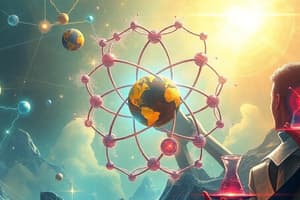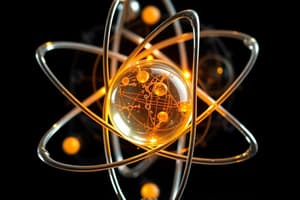Podcast
Questions and Answers
What was a significant improvement of Bohr's atomic model over JJ Thompson's plum pudding model?
What was a significant improvement of Bohr's atomic model over JJ Thompson's plum pudding model?
- Explained why elements have different numbers of electrons (correct)
- Described the behavior of neutrons
- Introduced the concept of electron spin
- Defined the shape of electron orbits
According to Bohr's atomic model, electrons orbit around the nucleus in distinct energy levels called __________.
According to Bohr's atomic model, electrons orbit around the nucleus in distinct energy levels called __________.
- Shells (correct)
- Rings
- Zones
- Layers
What key concept did Bohr's atomic model introduce to explain electron behavior within an atom?
What key concept did Bohr's atomic model introduce to explain electron behavior within an atom?
- Magnetization
- Ionization
- Quantization (correct)
- Polarization
In Rutherford's gold foil experiment, what was the surprising observation when alpha particles were fired at the gold foil?
In Rutherford's gold foil experiment, what was the surprising observation when alpha particles were fired at the gold foil?
What was Ernest Rutherford trying to confirm through his gold foil experiment?
What was Ernest Rutherford trying to confirm through his gold foil experiment?
Which feature of Rutherford's gold foil experiment contradicted Thompson's plum pudding model?
Which feature of Rutherford's gold foil experiment contradicted Thompson's plum pudding model?
What did Rutherford's results disprove?
What did Rutherford's results disprove?
What is the primary composition of an atom according to the text?
What is the primary composition of an atom according to the text?
Why do atoms with more tightly bound electrons exhibit stronger chemical reactivity?
Why do atoms with more tightly bound electrons exhibit stronger chemical reactivity?
Which scientist's work laid the groundwork for modern chemistry theories like quantum mechanics?
Which scientist's work laid the groundwork for modern chemistry theories like quantum mechanics?
Why was Dalton's Atomic Theory revolutionary for its time?
Why was Dalton's Atomic Theory revolutionary for its time?
What does the text imply about Bohr's hypothesis after Rutherford's results were known?
What does the text imply about Bohr's hypothesis after Rutherford's results were known?
Study Notes
Chemistry: Exploring the World Below the Microscope Lens
The field of chemistry has been instrumental in shaping our understanding of matter and its behavior. From figuring out how atoms come together to form elements and compounds, to deciphering complex reactions and interactions between them, chemists have paved the way for our scientific advancements. Let's delve into some key concepts that led us to this point.
Bohr's Atomic Model
Danish physicist Niels Bohr proposed his atomic model in 1913, which revolutionized our view of the atom. According to this theory, electrons orbit around the nucleus of an atom in distinct energy levels called shells or orbitals. This was a significant improvement over previous models like JJ Thompson's plum pudding model because it explained why different elements had varying numbers of electrons without being an unnecessarily dense blob. It also introduced the idea of quantization, where electrons can only exist in specific energy states, rather than continuous ones.
Rutherford's Gold Foil Experiment
In 1911, New Zealand-born scientist Ernest Rutherford performed what is now known as the gold foil experiment. He fired high-energy alpha particles through a thin sheet of gold with the intention of proving Thompson's plum pudding model right—instead, he found something very surprising: most of the incoming alpha particles went straight through the foil, while others were deflected sharply back towards their source! That meant there must be empty space inside the atom, with a tiny but massive positively charged core called the nucleus. This result strongly supported Bohr's hypothesis and allowed him to refine his ideas further.
Thomson's Atomic Model
Thompson believed that all positive charge was distributed evenly throughout the atom, including within the electron cloud. In other words, every point in an atom carries equal amounts of both negative and positive charges canceling each other out. But when Rutherford's results came out, they disproved Thomson's model completely!.
Structure of Atom
We now know that an atom consists primarily of protons and neutrons in its nucleus, surrounded by a group of electrons in various layers or shells. Protons carry positive electric charges and neutrons have neither; hence, if there aren't enough protons present to counteract the extra electromagnetic attraction caused by additional electrons attracted to these excess negatively charged particles within different regions of their own electrons clouds. Hence, we say these types have more tightly bound electrons than those with fewer electrons per region due to this additional force holding them close together. This explains things such as chemical reactivity - why certain materials might bind strongly under specific conditions but dissolve readily under others depending upon whether you pull them apart into individual pieces like breaking up ice cubes from water melting into liquid state after adding heat.
Dalton's Atomic Theory
This concept postulates that elements consist solely of tiny indivisible units called atoms. It was revolutionary for its time since people thought everything could break down into smaller parts until John Dalton proved otherwise. His work laid the groundwork for modern chemistry theories like quantum mechanics or general relativity. Similarly, Dalton showed how combining multiple atoms leads to molecules able interact differently based not merely different compositions but also vary according particular arrangement unique patterns matter arranges itself at microscopic scales..
These theories may seem simple today, but they opened a whole new world of exploration to scientists who continued building off that foundation with ever more intricate understandings. And remember, just like your body needs food to grow healthy cells, science needs curiosity to gain knowledge about its mysterious universe!
Studying That Suits You
Use AI to generate personalized quizzes and flashcards to suit your learning preferences.
Description
Explore key atomic models and theories that have revolutionized our understanding of matter, from Bohr's atomic model to Dalton's atomic theory. Dive into experiments like Rutherford's Gold Foil Experiment and learn about the structure of the atom.




